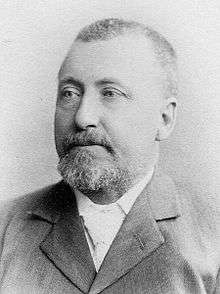Henry Charlick
| Henry Charlick | |
|---|---|
 Henry Charlick in 1898 | |
| Full name | Henry Charlick |
| Country | Australia |
| Born |
8 July 1845 London, England |
| Died |
26 July 1916 (aged 71) Adelaide, Australia |
Henry Charlick (8 July 1845 London, England – 26 July 1916 Adelaide, Australia)[1] was a leading Australian chess master in the 1880s. He won the second Australian Chess Championship at Adelaide 1887 with 7.5 points out of 9 games, ahead of reigning champion Frederick Karl Esling (7 points) and George H. D. Gossip (6.5).[2][3] Charlick scored 6/8 in the third championship at Melbourne 1888, tying for first with William Crane, Jr., ahead of William Tullidge (5.5), but narrowly lost the playoff to Crane (1 win, 2 losses, 1 draw).[4]
Charlick Gambit
In the early 1890s, Charlick introduced the dubious chess opening 1.d4 e5?!, which is sometimes called the Charlick Gambit. Charlick's idea was to meet 2.dxe5 with the gambit 2...d6 "with the object of preventing White from playing a close game."[5] Today, 1.d4 e5 is usually called the Englund Gambit, and the 2.dxe5 d6 offshoot that Charlick pioneered is usually called the Blackburne–Hartlaub Gambit.[6] Modern theory considers 2...d6 even more dubious than the main line 2...Nc6 3.Nf3 Qe7, since White obtains a large advantage after 2...d6 3.Nf3 Bg4 4.Bg5! Qd7 5.exd6 Bxd6 6.Nbd2.[7]
Illustrative games
Following are two games showing Charlick's attacking style of play.
Position after 13. Nh4
|
Final position
| ||||||||||||||||||||||||||||||||||||||||||||||||||||||||||||||||||||||||||||||||||||||||
Apperly vs. Charlick, Correspondence, Australia 1894:[8]
1. d4 e5 2. dxe5 d6
- Charlick's favorite gambit.
3. Bf4 Nc6 4. exd6 Qf6 5. Bc1 Bxd6 6. c3 Bf5 7. e3 O-O-O 8. Nd2 Qg6 9. h3 Nf6 10. Ngf3 Rhe8 11. Qa4 Bc2 12. Nb3 Ne4 13. Nh4 Qg3! 14. fxg3 Bxg3+ 15. Ke2 Bd1# 0–1
Charlick vs. William Crane, Jr., Australian Championship playoff 1888:[9]
1. e4 e5 2. Nf3 Nc6 3. Nc3 Nf6 4. Bb5 Bb4 5. d3 d6 6. O-O O-O 7. Ne2 Ne7 8. Ng3 Ng6 9. Bg5 Be6 10. c3 Bc5 11. Nh5 c6 12. Ba4 Bg4 13. Nxf6+ gxf6 14. Bh6 Re8 15. h3 Bd7 16. b4 Bb6 17. Bb3 Be6 18. Nh2 f5 19. exf5 Bxf5 20. Qf3 Be6 21. Ng4 Bxb3 22. Nf6+ Kh8 23. Nxe8 Bc2 24. Qxf7 1–0
References
- ↑ Jeremy Gaige, Chess Personalia: A Biobibliography, McFarland & Company, 1987, p. 68. ISBN 0-7864-2353-6.
- ↑ Gino Di Felice, Chess Results, 1747-1900, McFarland & Company, 2004, p. 103. ISBN 0-7864-2041-3.
- ↑ Diggle, G.H., "The Master Who Never Was", British Chess Magazine, January 1969, pp. 1-4, at p. 2. The title refers to Gossip, not Charlick.
- ↑ Di Felice, p. 111.
- ↑ David Hooper and Kenneth Whyld, The Oxford Companion to Chess, Oxford University Press, 2nd ed. 1992, p. 73. ISBN 0-19-866164-9.
- ↑ See Ken Smith and John Hall, The Englund Gambit and the Blackburne-Hartlaub Gambit Complex, Chess Digest, 1994, pp. 8-9, 15. ISBN 0-87568-242-1.
- ↑ Smith and Hall, p. 110.
- ↑ Apperly-Charlick, correspondence 1894
- ↑ Charlick-Crane, Australian Championship playoff 1888
External links
- Henry Charlick player profile and games at Chessgames.com
|
